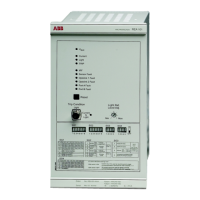Arc Protection Relay REA 10_
1MRS750929-MBG
6
Optolink communication
The REA 101 relay contains two communica-
tion links: Optolink 1 and Optolink 2.
The selection switches are use
d to select the
links to be used, and the messages to be com-
municated between them.T
he purpose of the
communication link is to communicate
ON/OFF type messages between the central
units over the signal transfer fiber. The mes-
sage can be:
• Light signal
• Overcurrent signal
• Trip signal
Only one type of message per optolink can be
tran
smitted between the central units. The
data to be communicated depends on the sys-
tem design.
To monitor the connection, a test pulse is sent
through
the signal transfer fiber at regular
intervals. If the test pulse is not received at
the specified time, the optolink fault LED
(“Optolink 1 Fault” or “Optolink 2 Fault”)
and the “IRF” LED of the central unit is lit,
and the IRF relay resets.
Circuit-breaker failure protection
The circuit-breaker failure protection (CBFP)
is enabled, when the Trip Condition key
switch is in “Current&Light” position.
The circuit-breaker failu
re protection is
implemented by delaying either the HSO2
output or the TRIP3 output, or when required,
both the outputs. Note that if both the outputs
are used, the delay time is the same, but the
pick-up time of the relay (5...15 ms) is added
to the TRIP3 relay.
The selection switches are use
d to select the
wanted alternative.
The selected delay time, 100 ms or 150 ms,
s
tarts running once the HSO1 is activated.
Delayed tripping does not take place if the
overcurrent signal disappears before the spec-
ified time delay elapses.
When the circuit-breaker
failure protection is
not in use, all the trip outputs operate in paral-
lel.
Self-supervision unit
In addition to that mentioned in the above
sections, the self-supervision unit (IRF) mon-
itors the operating voltage of the relay. If a
faul
t is detected in the operating voltages, the
self-supervision unit prevents the relay from
operating. In addition, the “IRF” LED of the
central unit is lit, and the IRF relay resets.
The self-supervision signal output operates
on the clos
ed circuit principle as presented in
the figure below. Under normal conditions,
the output relay is energized and the contact
gap between 8 and 10 is closed. If the auxil-
iary power supply fails, or an internal fault is
detected, the contact gap between 8 and 10 is
opened.
A050349
Fig. 3 Self-supervision output (IRF)
Extension unit REA 103
The Arc Protection Module REA 103 is an
extension unit designed to be used together
with the central unit REA 101.
The function of the REA 103 unit is to detect
li
ght and to provide the REA 101 relay with
information about this.
The use of the extension unit allows the pro-
tection area to be extended
and the protected
object to be divided into smaller areas
Features:
• Two sensor fibers for arc detection; loop or
radial arrange
ment
• Two signal relays for each sensor fiber
• Relays activated by light
detected by the
sensor fiber
• Two RJ-45 ports for connecting REA 101
relay and exten
sion units
• Self-supervision unit monitoring operat-
ing voltages and sensor fiber loops.
Extension unit REA 105
The Arc Protection Module REA 105 is an
extension unit designed to be used together
with the central unit REA 101.
The function of the REA 105 unit is to detect
li
ght and to carry out tripping, if the REA 101
relay provides an overcurrent signal at the
same time, or delivers a trip command.
The use of extension units allows the protec-
tion area to be extended and the protected
ob
ject to be divided into smaller areas. Thus a
more selective system is obtained.
IRF
9
8
10
IRF
8
10
9
Normal condition Fault condition

